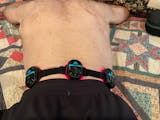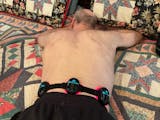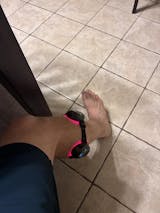Runner’s knee, also known as patellofemoral pain syndrome, is a common issue for athletes, particularly runners. It refers to pain around or behind the kneecap that worsens with activities like running, squatting, or climbing stairs. While the condition can be uncomfortable, it is treatable and manageable with the right approach. Understanding its symptoms, causes, and treatments—such as
medical-grade red light therapy devices—can help alleviate discomfort and support healing.
What Is Runner’s Knee
Definition and Overview of Runner's Knee
Runner's knee is a term used to describe pain around the kneecap (patella). It's a common condition, especially among athletes who engage in repetitive knee motions. The pain is usually centered at the front of the knee, and it may feel like a dull ache that intensifies with physical activity, especially running or kneeling.
Symptoms of Runner’s Knee
The most noticeable symptom of runner's knee is pain near the kneecap. You may feel the pain increase during activities such as running, squatting, or even sitting with your knee bent for a long time. Some people also experience swelling, stiffness, and a sensation of instability in the knee joint.
Causes of Runner’s Knee
Several factors contribute to runner’s knee. Overuse, improper alignment of the knee, muscle imbalances, and tight or weak muscles around the knee can all be causes. Running, cycling, or other repetitive motions put extra stress on the knee, leading to irritation and discomfort.
How Does Runner’s Knee Affect the Knee Joint
The Role of the Patella in Knee Movement
The patella (kneecap) sits between the femur and tibia, allowing smooth movement of the knee. When the patella becomes misaligned or does not track properly, it can cause increased friction, which leads to pain and inflammation. This misalignment is often the primary cause of runner's knee.
Impact of Misalignment on Knee Function
Misalignment of the patella can lead to improper distribution of pressure across the knee joint. This causes increased wear on the cartilage, resulting in inflammation and pain. Over time, if left untreated, it can even cause long-term damage to the knee’s structure.
How Overuse Contributes to Runner’s Knee
Overuse is one of the most common causes of runner’s knee. Engaging in repetitive activities like running, cycling, or jumping places continuous stress on the knee joint. Over time, this can irritate the tissues around the kneecap, leading to pain and swelling.
Who Is At Risk for Developing Runner’s Knee
Athletes and Active Individuals
Anyone who participates in activities that involve repetitive knee movement, such as running, biking, or playing sports, is at risk. These individuals are often putting excess strain on the knee joint, which can lead to overuse injuries like runner’s knee.
Age and Gender Factors
Runner’s knee can affect people of all ages, but it is especially common in young, active individuals. It’s also more prevalent in women, as their broader hips can lead to greater misalignment in the knee joint, making them more susceptible to this condition.
Pre-existing Knee Issues
People who have had previous knee injuries or who suffer from poor posture and alignment are more likely to develop runner’s knee. Weak quadriceps, tight hamstrings, or flat feet can also contribute to the development of this condition.
What Are the Symptoms and Signs of Runner’s Knee
Pain Around the Kneecap
The most common symptom of runner's knee is pain located around the front of the knee or behind the kneecap. This pain often worsens with physical activity, such as running, squatting, or even going up and down stairs. In some cases, the pain may subside with rest but return once activity is resumed.
Swelling and Stiffness
In addition to pain, you may notice swelling in the knee. This swelling is typically caused by inflammation around the kneecap and can limit the knee’s range of motion. Stiffness may also be present, especially after periods of inactivity.
Crepitus (Crunching Sensation)
Some individuals may experience crepitus, a grinding or crunching sensation when moving the knee. This is usually a result of friction between the patella and the underlying bone due to misalignment or cartilage damage.
How Is Runner’s Knee Diagnosed
Physical Examination by a Healthcare Provider
A doctor will typically start by performing a physical exam. They will check for signs of swelling, tenderness, and misalignment around the kneecap. They may also test the knee’s range of motion to assess whether the pain worsens with certain movements.
Imaging Tests (X-rays and MRIs)
In some cases, imaging tests like X-rays or MRIs may be needed to confirm the diagnosis. These tests help rule out other possible causes of knee pain, such as fractures, arthritis, or ligament damage. MRIs can also show the condition of the cartilage and surrounding tissues.
Evaluating Movement Patterns
Your healthcare provider may also assess your running or walking gait. This can reveal any abnormalities in how you move, which may be contributing to the development of runner’s knee.
Treatment Options for Runner’s Knee
Rest and Activity Modification
The first line of treatment for runner’s knee is often rest. Giving the knee time to heal by reducing activities that exacerbate the pain is essential. Once the pain subsides, you can gradually return to activity, but you should modify your routine to avoid further injury.
Physical Therapy
Physical therapy is a key component in the treatment of runner’s knee. A physical therapist will guide you through exercises to strengthen the quadriceps and improve flexibility. This can help address muscle imbalances and prevent the knee from becoming misaligned.
Use of Medical-Grade Red Light Therapy Devices
For quicker recovery and pain relief, many people turn to
red light therapy devices. These devices help reduce inflammation and promote healing by stimulating blood flow in the affected area.
FDA approved red light therapy can also help reduce muscle tension and improve joint mobility.
Pain Relief with Ice, Heat, or Medications
Ice packs can reduce inflammation and numb pain, while heat helps to relax tight muscles around the knee. Over-the-counter medications like ibuprofen can also be used for pain relief and to reduce swelling.
Prevention: How to Avoid Runner’s Knee
Strengthening Exercises for the Quadriceps
One of the most effective ways to prevent runner’s knee is to strengthen the muscles around the knee, particularly the quadriceps. Regularly doing exercises like squats or lunges can help keep the knee stable and aligned.
Proper Footwear and Orthotics
Wearing shoes that provide good arch support can help prevent misalignment. In some cases, custom orthotics may be recommended to correct foot issues that contribute to runner's knee.
Gradual Increase in Activity Level
To prevent overuse injuries, it’s important to gradually increase the intensity and duration of your physical activities. Avoid sudden spikes in activity, as this can place undue stress on your knees and increase the risk of injury.
Using Red Light Therapy Devices for Prevention
For long-term knee health, incorporating
red light therapy machine - PRUNGO FluxGo into your routine can help prevent inflammation and support muscle recovery. These devices can be especially beneficial after intense workouts or long runs.
Conclusion
Runner's knee is a common but fully manageable condition that often troubles many sports enthusiasts. If you are experiencing knee pain, understanding the cause and choosing the right treatment is crucial. Physical therapy, adequate rest, and medical-grade red light therapy devices can all effectively accelerate recovery. For cases requiring extensive treatment,
red light panels are ideal; if your goal is facial care,
red light masks can simultaneously address multiple facial areas, especially suitable for anti-aging, soothing, and repairing, effectively improving skin condition, reducing fine lines, evening out skin tone, and alleviating acne problems.

























0 comments